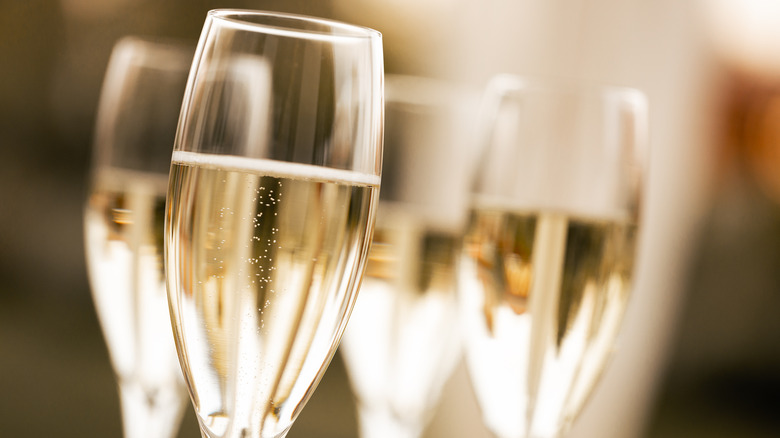Use Your Leftover Champagne For A Deliciously Elevated Vinaigrette
An integral cultural necessity in its namesake region of northeastern France and across the world, Champagne — not to be confused with its non-local counterpart simply referred to as "sparkling wine" — has steadily become the signature drink of all sorts of milestones and celebrations. Known for its light, lively flavor profile, sharp acidity, and velvety texture, Champagne possesses a pleasant array of fruity flavors, and, whether dry, brut, or even demi-sec, its versatility stretches far beyond providing a few good dinner toasts. In fact, once you've sipped your way through a classic mimosa or two, you should definitely hang on to that leftover Champagne, as it can be delightfully repurposed to make a light, delicious addition to your salad course. That's right — in just a few simple steps, you can transform that leftover bubbly into a flavorful, homemade Champagne vinaigrette that might just end up being your best — and most delicious — party trick.
Using leftover Champagne for your vinaigrette
A vinaigrette typically consists of a base ratio of one part vinegar to three parts oil — and a Champagne vinaigrette typically begins with making a Champagne vinegar base to build upon. The good news is that making Champagne vinegar is a reasonably simple, low-lift process even if it is a test of patience. You'll simply leave your leftover Champagne in a widemouthed mason jar or cup at room temperature covered in plastic wrap or cheesecloth — however, if you use plastic wrap, it's important to poke a few holes in the top for ventilation. Leave it alone for four weeks to six months, and the Champagne will become vinegar through a second fermentation process that occurs when aging it.
When you're ready to use your Champagne vinegar, you'll just whisk it with your other ingredients to taste — olive oil, honey, mustard, garlic, shallots, whatever you'd like — in a process called emulsifying, and you'll make a pleasantly tart, refreshingly light vinaigrette to rival your favorite store-bought brand. If you can't wait for your Champagne to become vinegar, you can use your Champagne as is and substitute lemon juice as your acid. But, use a tad less lemon juice than the amount of vinegar called for to balance out the acidity. When all is said and eaten, if you want to save that delicious leftover dressing — and you will — you can keep your Champagne vinaigrette in an airtight container in the refrigerator for up to five days.
Other delicious uses for leftover Champagne
Luckily, innovative uses for Champagne in food and entertaining are plentiful. For example, Champagne can also be used to deglaze a pan by adding it to a hot pan that has just been used to cook, say, steak. Simply add your Champagne and let it simmer before scraping up the residue left behind. When it thickens, it will be a delicious, gravy-like pan sauce you can use to top your meat. If you'd like, you can even add some seasonings. Champagne can also be added to your pancake batter for a delicious spin on a classic breakfast. Just add ¾–1 cup of your Champagne, and you're cooking.
And, what cocktail wouldn't be elevated with the addition of a few Champagne ice cubes? Charmingly easy to make, you simply pour your leftover Champagne into an ice tray and freeze it for at least six hours, and you've got a classy and fun way to keep your drinks cold. Champagne can also be mixed into your chocolate ganache with some butter to make some decadent, no-bake truffles with a little buzz, and your leftover flat Champagne will work just as well. With just a little bit of creativity, you can elevate the elegance factor of some of your basic dishes — after all, when it comes to Champagne, first comes the toast, then comes the most.


